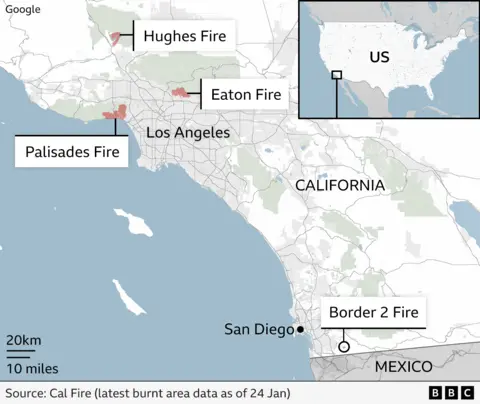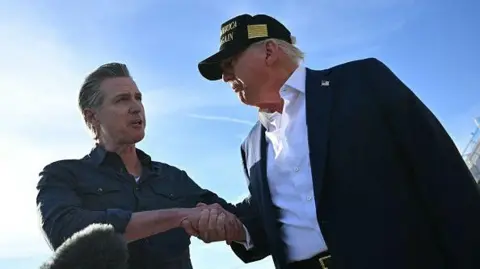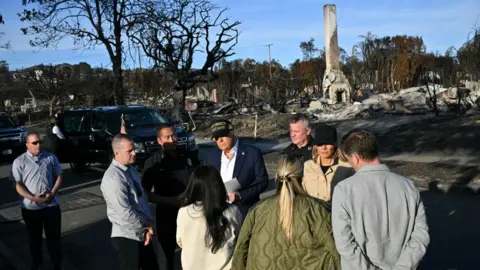BBC News
President Donald Trump travelled to California on Friday to survey the destruction from deadly wildfires that devastated several communities in the Los Angeles area earlier this month.
The visit, coming at the end of Trump’s first week back in office, took place as he continued to denounce the state emergency response being led by Democratic Governor Gavin Newsom – one of Trump’s fiercest critics – and worries the president might withhold aid over policies in the liberal state.
Despite the political rivalry, Newsom greeted Trump on the tarmac as he emerged from Air Force One, arriving from North Carolina where he toured damage from Hurricane Helene, which rocked the western part of the state in September.
Trump’s visit came as new fires ignited in southern California, and local officials continue to contend with dry and windy weather conditions that favour fire growth.

Speaking to reporters after shaking hands with Newsom, Trump said: “I appreciate the governor coming out and meeting me”.
“We want to get it fixed,” he continued, telling Newsom that aftermath looks “like you got hit by a bomb”.
Newsom, who Trump has nicknamed “Newscum”, then thanked Trump for coming to visit, telling him: “We’re going to need your support, we’re going to need your help”.
“You were there for us during Covid, I don’t forget that, and I have all the expectations that we’ll be able to work together to get this speedy recovery,” Newsom continued.
Trump then toured the ruins of Pacific Palisades neighbourhood with his wife Melania, and then attended a roundtable discussion with local leaders, including LA Mayor Karen Bass. He vowed to sign an executive order that would pump water from northern parts of the state to the south.
He quarrelled briefly with Mayor Bass after she said that residents must be patient – because clean-up crews need time to clear “hazardous waste” such as toxic ash from things like lead, polyaromatic hydrocarbons and asbestos – before they can return to their homes.
“What’s hazardous waste? I mean, you’re going to have to define that,” Trump remarked, adding: “I just think you have to allow the people to go on their site and start the process tonight.”
New blazes – named Laguna, Sepulveda, Gibbel, Gilman and Border 2 – flared up on Thursday in the counties of Los Angeles, San Diego, Ventura and Riverside – all in southern California.
Firefighters have made progress in bringing the 10,000-acre Hughes Fire in Los Angeles under control, containing it by 79% since it broke out on Wednesday, forcing tens of thousands of people to evacuate.
Fires have devastated the US state over the last few weeks, with the Palisades and Eaton fires scorching a combined total of more than 37,000 acres and killing at least 28 people. Multiple neighbourhoods have been levelled, leaving more than 10,000 homes and businesses in ashes.
 Getty Images
Getty Images“Unfortunately, it’s a very sad period, but what makes you feel good is I met so many of the homeowners, and every one of them, a lot of them, and every one of them said to me, they want to rebuild,” Mr Trump said after flying over by helicopter and touring the ruins on foot.
“The federal government is standing behind you 100%,” he told local leaders.
Governor Newsom on Thursday announced a $2.5bn (£2bn) state-level aid package to deal with the fire damage.
Trump has been critical of the response to the California fires, threatening to withhold federal assistance unless the state does not change its water laws and implement laws requiring an ID to vote in elections.
“After that, I will be the greatest president that California has ever seen,” Trump said earlier.
California does not usually require ID to vote but does to register to vote.
Newsom’s office said in a statement on social media that: “Conditioning aid for American citizens is wrong”.
 Getty Images
Getty ImagesBrian Rice, the president of the California Professional Firefighters, told the BBC that he hopes Trump does not deny the state federal aid.
“The most important focus we have is getting federal aid into California, into these communities where people have lost their lives, their homes,” he said.
The city is set to host both the 2028 Summer Olympics and Fifa World Cup matches in 2026 – two global events that will thrust the Los Angeles region into the spotlight.
Trump has also been critical of the work done by the Federal Emergency Management Agency (Fema) – which is tasked with responding to such disasters – under the Biden administration.
He has suggested getting rid of the agency and letting US states manage disasters in their jurisdictions.
“Fema is a very expensive, in my opinion, mostly failed situation,” Trump told local leaders. “Each state should take care of their problem and get money from the federal government. It would be so much better.”
He made similar remarks during a visit to North Carolina, where at least 104 people were killed in a hurricane, claiming that “Fema was not doing their jobs” in that state.
He noted that some residents still don’t have power or hot water and it was “totally unacceptable”.
Asked by the BBC whether he would withhold federal aid to California, but not North Carolina, Trump said that the situations in the two states are different.
His response came after he touted the “big numbers” North Carolina had given him when he carried the state in the 2024 presidential election. He later noted that he had won the state in every general election and Republican primary contest in which he had been on the ballot.
Meanwhile, California has consistently voted against Trump in the past three presidential elections by substantial margins.
Los Angeles is under an elevated fire risk area today with brisk winds, according to BBC Weather.
Rain is expected over the weekend in the county, as well as snow up in the mountains of southern California.
However, while this will aid firefighting efforts, there are concerns that it could also cause flooding and dislodge debris from the fires, creating mudslides.
Specialist crews have been working to try and secure burned areas, while sandbags and other flood prevention supplies have been handed out to locals so that they can protect their properties.
Twenty-three people died in 2018 when mudslides hit the California town of Montecito, one of the areas that had recently been affected by the Thomas Fire.















